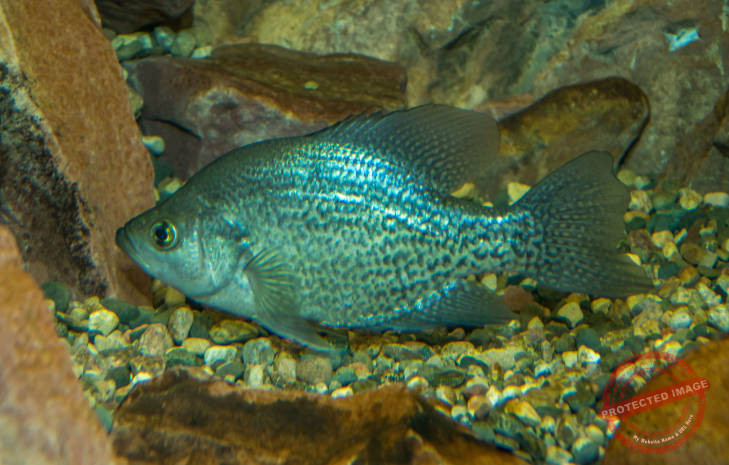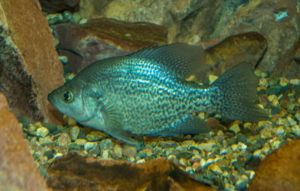As a child, your first experience fishing was likely common panfish. Although few anglers actually take the time to identify the various species. The panfish go by different names. In the south, they are called bream, and in the northeast, people refer to all panfish as bluegills. It does make a difference as some are considered threatened species in some waters.
An example is warmouth which looks a lot like rock bass. Where I live warmouth are endangered, but rock basses are plentiful. You need to know what you are keeping. As anglers, we have the responsibility to help with fishery management also. This requires the practice of selective harvest being used for a stable population. This applies to every species of fish.
Common Panfish; Sunfish
One of the more common panfish comes in several species. There are long ear, red-breasted, green, and a few other types of sunfish in freshwaters. The large population of this species makes them easy to catch. The problem with sunfish is they are often too small for eating. The larger ones are harvested and only small ones are released. As a result, this affects the population by removing the genetics of large sunfish.
Green Sunfish
- Larger mouth than other panfish.
- The lower jar reaches back to the middle of the eye.
- A rounded short pectoral fin.
- The pectoral fin is behind the eye.
Redbreast Sunfish
- Long narrow earflap of either black or blue-black.
- Earflap is narrower than the eye.
- Olive green body fading into a bronze yellow.
- Several light blue lines come from the mouth.
- Short round pectoral fins.
Long Eared Sunfish

- A smaller mouth than other panfish.
- The upper jaw extends back to the eye.
- Blue or teal stripes reach from the mouth to the opercular flap.
- A dark and flexible opercular flap with a thin white or red margin.
- Has a short pectoral fin when folded forward that does reach the eye.
Red Ear Sunfish
- Light golden green above with a white or yellow belly.
- The fins tend to be mostly clear.
- A fairly pointed snout with a small mouth.
- Connected dorsal fins and long pointed pectoral fins.
Spotted Sunfish
- There are two subspecies orange-spotted and red-spotted.
- A small mouth and the upper jaw do not reach the eye.
- Short rounded pectoral fins.
- The back is olive to brown with pale olive sides with blueish highlights.
- Short broad earflap with a margin on the outer edge.
Common Panfish; Bluegill and Pumpkin Seed
Bluegill
- A small mouth relates to body size.
- The upper jaw extends to the front of the eye.
- Earflap is dark with a dark margin.
- Soft dorsal fin with a black dot.
- Has vertical barring on the sides.
Pumpkin Seed
- Brilliantly colored olive green with blue and orange dots.
- A light gold streak along the bottom edges.
- Wavy blue lines on the check.
- The short ear flap has a bright red or orange dot.
Common Panfish; Crappies and Rock Bass
Crappies tend to be an exception to using worms as live bait. This panfish is easier to catch on small minnows and jigs. They have a larger mouth allowing them to swallow a minnow whole. This is a common trait among the bass species.
Black Crappie
- An overall mottling with an evenly distributed pattern.
- The body is round.
- Has 8 dorsal spines.

White Crappie
- Vertical bar pattern to the mottling.
- An elongated body with a little more pronounced snout.
- Has 5 dorsal spines.
Rock Bass
- A thicker heavily-bodied fish with large eyes.
- Body color is dark slate to olive with a coppery or bronze tone.
- A large mouth that extends to the eye.
- It has six anal fins spines, which is more than the warmouth.
- Two connected dorsal fins.
Warmouth
- It looks almost the same as the rock bass.
- It only has three anal fin spines, the easiest way to identify it.
- The warmouth has teeth on its tongue, rock bass does not.
- The check plate is slightly different than a rock bass’.
Common Panfish Gear
The majority of panfish rarely grow to 10 inches and less in heavily fished waters. As a result, you only need an ultra-lite tackle. The lighter tackle allows the fish to fight to make it more enjoyable for the angler. The lighter line used on these rods will also produce more bites. Since the fish can notice a heavy line in shallow waters.
Finding panfish is easy since they are common in lakes and ponds near the shore. The areas with brush piles and weeds hold the most fish. You need to check those areas first. Do not get too close as it may spook the fish. Stay a comfortable casting distance away from the cover the fish are using. This will prevent the fish from seeing you.
Panfish species are aggressive and will eat anything. Although in many instances worms and other insects work best. The worms are available in many stores or can be dug up in your yard. Maggots or mealworms are other options, these also can be bought in tackle shops or at Walmart. A panfish will eat smaller baits easier, as a result, this reduces missing fish due to early hook sets.
Small lures work for panfish, try using small flies, poppers, and jigs catch to catch them. Using artificial bait creates more of a challenge. This is desirable for some anglers since catching fish quickly and often can be tedious or boring. The type of panfish you target can create more of a challenge also. Crappies are a bit more elusive than the other species.
Panfish Combos at Bass Pro
Eating Common Panfish
The crappies make excellent table fare. A favorite among experienced anglers and preferred over bluegills and sunfish. Try to find a lake where crappies are abundant and catch a few. Since they give a better fight compared to other panfish.
The other panfish are also fine to eat. The area you live in may or may not have an ample population of good-sized fish. The panfish vary in size among the species but all can reach a decent size to eat. As with all fish only keep what you will eat and release the others. The larger panfish, over ten inches should be released to practice selective harvest.
The practice of selective harvest is the best way to improve a fishery. The act of releasing the larger adults increases the population. This keeps genetics better. The large fish breed more large fish. If you live in an area with a lot of small panfish, it is a result of the large fish being over-harvested.
Book showing the fish of North America on Amazon
Common Panfish Conclusion
The panfish are fun to catch and enjoyable to eat. Fishing for panfish will only get better with more anglers practicing selective harvest. It only takes three to four years to improve a fishery. Releasing the bigger fish now will result in having larger fish for the future and more of them.
John McIntyre
